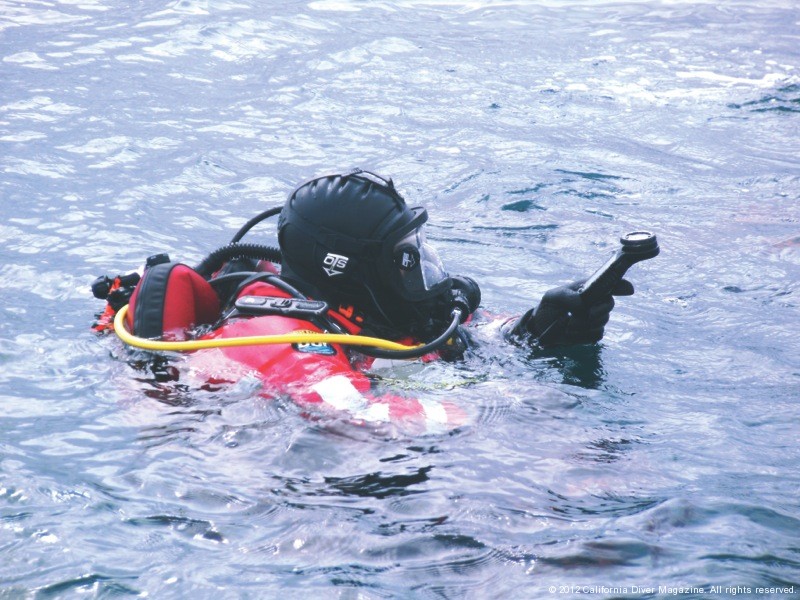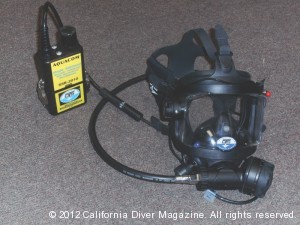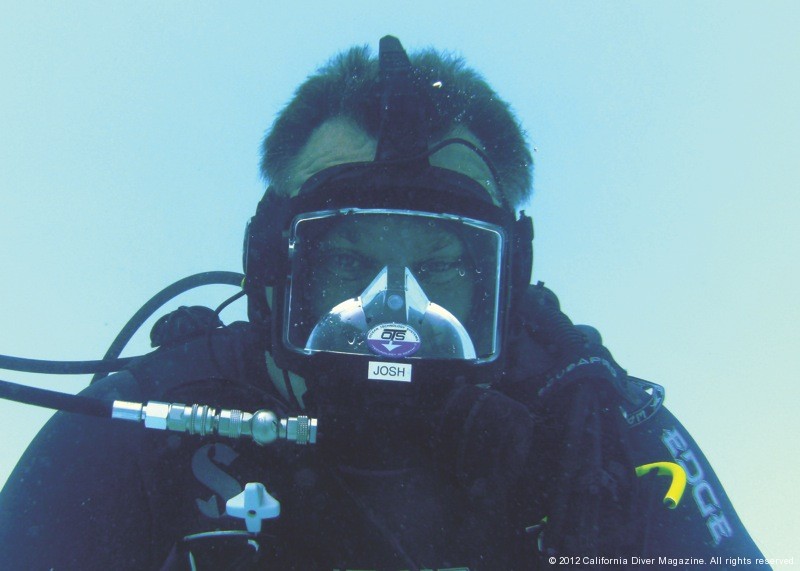Full-face masks have been used by military, scientific, commercial, TV/movie industry, and public safety divers for many years. Full-face masks (FFM) are favored by these professionals over the typical half-mask and second stage regulator set up (held in the diver’s mouth), which sport divers are accustomed to. We will discuss why in a moment. In the past few years, more and more sport divers have been expressing an interest in full-face masks, and some diving equipment manufacturers are seriously starting to market FFMs to sport divers. This article will discuss some of the advantages of diving with a full-face mask, along with other information a sport diver needs to know when buying or using a FFM. Description
———————————————————————–
Words & Photos by Josh Roten
____________________________________________
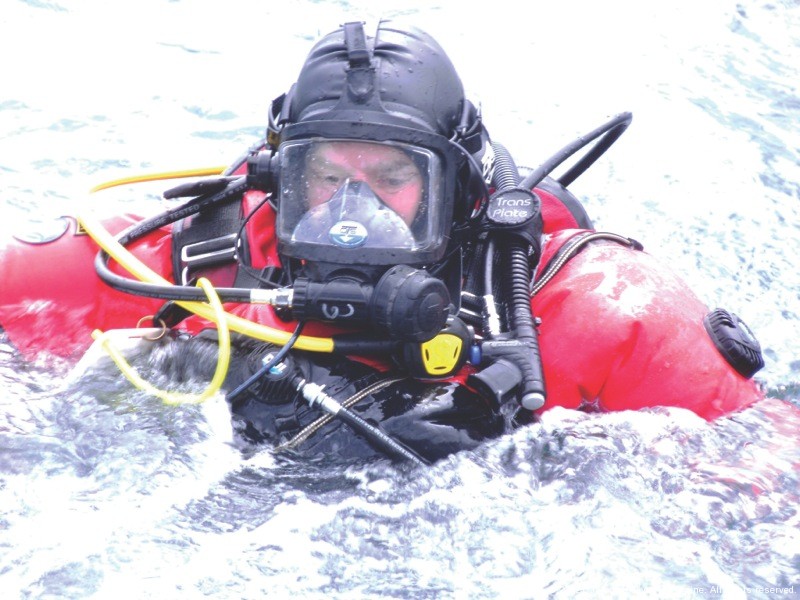 Above: A public Safety Diver using a Full Face Mask
Above: A public Safety Diver using a Full Face Mask
What is a full face mask?
First, let’s define what a full-face mask is. As the name implies, a FFM covers the diver’s entire face: eyes, nose, and mouth, all with a single piece of equipment. Depending on the make and model, some FFMs have second stages that are part of, or integrated into, the FFM. Other makes and models will accept a standard second stage regulator once the mouthpiece has been removed and the standard second stage is connected to the FFM. The diver does not have a mouthpiece held in the teeth with either configuration. It is possible to breathe through your mouth and nose, or even just your nose, when diving with a FFM. Both styles are perfectly fine, but one advantage of the integrated second stage is the design often allows the incoming (fresh, cool) air to enter the FFM along the inside of the lens, which serves to prevent fogging of the mask without the need for anti-fog solution to be applied before the dive, and even in extremely cold water. Most FFMs have some type of “Ambient Breathing Valve,” or “Surface Air Valve,” et cetera, so the diver can keep the mask in place on the surface, opening that valve to conserve tank air before or after the dive. This takes the place of having a snorkel. Most FFMs on the market today also come equipped with a nose cup, which directs warm, exhaled air directly out of the mask, primarily to prevent carbon dioxide build-up inside the mask, but also to help prevent fogging. We will discuss additional features commonly found on FFMs in a moment, but first let’s talk about the advantages of using a FFM.
Advantages of full face masks
As mentioned above, many professional divers use FFMs. Why? There are several good reasons and most relate to safety. FFMs are more secure and less likely to become dislodged when inside confined areas, like inside sunken vessels, searching submerged cars or boats, or in areas with a lot of underwater obstacles or debris. This is because FFMs have a “spider strap” as a head strap and it has multiple (3-6) points of attachment to the FFM, depending on the make and model; whereas a half-mask has only one strap attached at two points. With a half-mask, if the strap breaks or comes loose you will probably lose your ability to seal the mask, but with a FFM it is possible to break one, or even more straps and the mask will usually remain sealed on the diver’s face. In addition, there is more mask in contact with the diver’s face. The larger seal area = more contact area = better seal.
FFMs also make a great platform for attaching popular accessories such as: voice communications, lights, and still or video cameras. This is typically accomplished with an accessory called a rail system, which easily attaches to the mask, and then your accessories can be attached to the rail system. Most underwater voice communication devices attach directly to the FFM and do not require the rail system. Underwater voice communications (comms) are probably the single-most common accessory found on FFMs. Comms allow divers to talk to each other, to the surface, and to interface the communications equipment with video camera systems, which means you can narrate the video as you shoot it underwater. Comms are an important safety feature for professional divers, and a convenience for sport divers, instructors, or Divemasters leading dives. Some divers prefer the peace and quiet of the underwater world without comms, which I completely understand. Diving with a FFM does not require the attachment, or even use of comms, but they are popular with many FFM divers.
———————————————————————–
Words & Photos by Josh Roten
____________________________________________
Another major advantage for professional divers comes when they are diving in polluted/contaminated water. The diver has better exposure protection from the dirty water because the mask covers the diver’s entire face. Also, in the event of a medical emergency underwater (heart attack, stroke, seizure, oxygen toxicity, etc.) where the diver becomes unconscious, his airway is kept dry because the FFM remains in-place and covers the entire face. The second stage regulator can’t fall out of an unconscious diver’s mouth when diving with a FFM. This could mean the difference between life and death due to the diver’s airway and lungs being dry and not full of water when the diver is rescued. FFMs do not flood easily; when the mask seal is broken, air flows out, which the second stage regulator reacts to by allowing more air into the mask, preventing water from entering the FFM. Many new FFM divers are surprised to learn how much effort is required to flood the mask with water when doing basic FFM “flood and clear” skills for the first time. In addition to these more serious advantages, many FFM divers report they: can breathe through their nose during the dive therefore preventing dry mouth, feel warmer during the dive, and don’t have jaw fatigue at the end of a day of diving from holding a second stage regulator in their mouth.
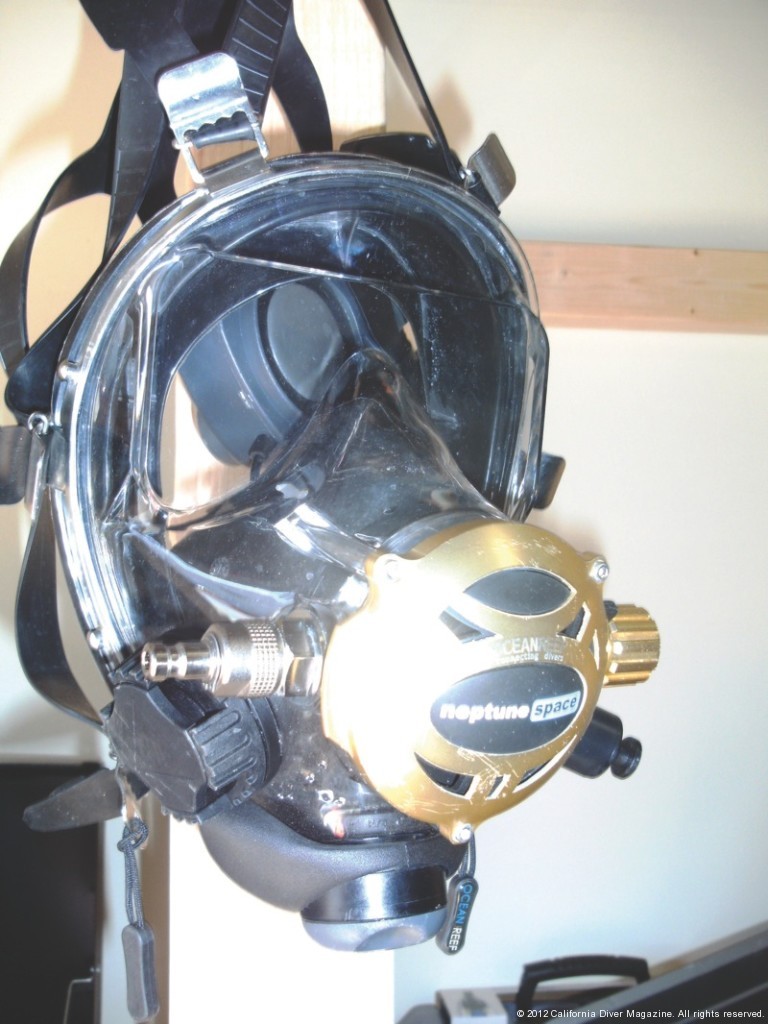
Above: The Ocean Reef FFM also has an integrated second stage regulator
What you need to know
Here are some other things a sport diver interested in a FFM needs to know. FFMs are usually more expensive than a standard half-mask and second stage regulator, but remember, if you are shopping for a FFM that has an integrated second stage you should consider the mask includes the cost of a second stage regulator, along with the many other advantages of a FFM, then make the appropriate price comparisons.
Using FFMs is as easy as the basic mask and regulator skills you learned in your first SCUBA class, but divers using a FFM should take specialty training from an instructor who has a background with FFMs and who is qualified to teach FFM skills and emergency/contingency procedures. The typical FFM skills include: donning and doffing, equalizing, flooding and clearing, removing and replacing underwater, out-of-air/air-sharing with another diver, and simulated FFM failure skills. All divers should always have an alternate air source available and FFM divers should also carry a half-mask (in a pouch, BC pocket, or around your neck backwards) in the unlikely event of an out-of-air or catastrophic FFM failure. Just for the record, in many years of FFM diving I have never experienced or seen a FFM failure and have only deployed my half-mask when teaching or practicing FFM skills. Most new FFM divers report a slight increase in Surface Air Consumption Rate (SAC-Rate) as compared to diving a half-mask and standard second stage held in the mouth, but many also report using less air when diving with a FFM once they get used to it, relax, and can breathe through their nose during the dive.
Equalizing manually is accomplished one of two ways: some FFMs have nose pockets much like a half-mask allowing the diver to pinch his nostrils just like when diving a half-mask, and some FFMs are equipped with a nose block system which allows the diver to adjust the nose block device(s) to fit him before the dive. If the diver needs to manually equalize during the dive, the FFM diver simply pushes up on the bottom of the mask slightly to engage the nose block(s) and attempts to equalize. Wrap-up If considering the purchase of a FFM, do your homework! Look at what the professionals are diving. They have done the research and development for you, and most likely have tried them all.
Just like any life support SCUBA gear, stick with equipment that is: made well, durable, has a good backing by the manufacturer, and is comfortable and fits you well. Also, be sure to contact an instructor who has a background in FFMs and is qualified to teach FFM skills so you get proper training in normal and contingency use and operations. The salesperson isn’t always that person!
I have been diving for 35+ years. I started using FFMs about 11 years ago because of my work assignment as a Fire Captain/Dive Rescue Team Leader. I immediately became hooked, and even now that I am retired, I still dive a FFM when training public safety divers and when diving for fun. I hope this article has given you new insight into diving full-face masks as sport divers, and I hope you investigate diving FFMs further. Special Thanks to James Smith, owner of Ventura Dive & Sport and Raptor Dive Charters, for the use of the pool for some of the photos used in this article. This article is intended to inform sport divers about the advantages and other issues related to diving with a full-face mask, however it does not replace the need for formal FFM training by a qualified instructor.
Author Bio:
Josh Roten has been diving for 35 years and is a NAUI Instructor/Specialty Instructor. He is a retired fire captain/dive rescue team leader and trains public safety divers in advanced search, rescue, recovery, salvage, contaminated water diving, current diving, and altitude diving as well as full-face mask and underwater voice communications. He may be contacted by visiting www.MAKODIVER.com, or by email at info.makodiver@gmail.com
Links to popular full-face mask manufacturers:
Ocean Technology Systems ‘Guardian’ http://www.oceantechnologysystems.com/
AGA ‘Divator’ / Interspiro http://www.interspiro.com/product-mk2.htm
The Kirby Morgan Company ‘EXO 26’ http://www.kmdsi.com/Products/FullFaceMain.html
Scubapro FFM http://www.scubapro.com/americas/english/scubapro-products/masks/masks/full-face-mask
Ocean Reef http://www.oceanreefgroup.com/
All photographs for this article are by the author.

